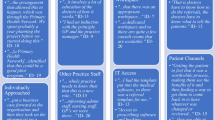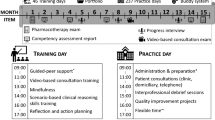Abstract
Purpose. The pharmaceutical care framework requires an active client-pharmacist partnership, particularly with respect to consultation about medications. With low client expectations for pharmacist consultation documented by several studies, this research sought to identify: 1) what information clients want from pharmacists, 2) what barriers prevent clients from asking pharmacists their questions, and 3) whether an inexpensive intervention could increase client short-term knowledge of pharmacist roles related to patient consultation and monitoring prescription appropriateness. Role theory provides a framework for this study.
Methods. Nineteen community pharmacies and 355 pharmacy clients participated in the study. Each client completed a survey on their needs for information and knowledge of pharmacist roles, with clients in the experimental arm receiving a short brochure on pharmacist roles while a control group did not.
Results. Sixty percent wanted information about side effects; 51% wanted directions for how to take the medication correctly. Most frequently listed barriers to asking pharmacists questions were client embarrassment and ignorance that it was appropriate to seek information from pharmacists. Significantly more experimental group clients than control group clients correctly answered survey questions about pharmacist roles and training. Only 52% of the control group believed the pharmacist always checks for possible drug interactions. Only 55% believed pharmacists were required to provide appropriate patient consultation for prescriptions under state law.
Conclusions. Brief exposure to a short pamphlet about pharmacists' activities increased knowledge of pharmacist roles and training, suggesting that inexpensive interventions can impact on client short term knowledge of pharmacist roles.
Similar content being viewed by others
REFERENCES
Commission to Implement Change in Pharmaceutical Education, Entry-Level Education In Pharmacy: A Commitment To Change, AACP News Special Report, 1991.
C. D. Hepler, and L. M. Strand. Opportunities and responsibilities in pharmaceutical care. American Journal of Hospital Pharmacy. 47:533–42 (1990).
L. M. Strand, R. J. Cipolle, P. C. Morley, and D. G. Perrier. Levels of pharmaceutical care: A needs-based approach. American Journal of Hospital Pharmacy. 48:547–50 (1991).
D. C. Brodie, W. F. McGhan, and J. Lindon. The theoretical base of pharmacy. American Journal of Hospital Pharmacy. 48:536–540 (1991).
W. E. Smith, and K. Benderev. Levels of pharmaceutical care: A theoretical model. American Journal of Hospital Pharmacy. 48:540–6 (1991).
R. P. Penna. Pharmaceutical care: Pharmacy's mission for the 1990's. American Journal of Hospital Pharmacy. 47:543–549 (1990).
E. J. Dole. Beyond pharmaceutical care. American Journal of Hospital Pharmacy. 51:2183–2184 (1994).
L. M. Strand, R. J. Cipolle, and P. C. Morley. Pharmaceutical care: An introduction. In Current Concepts. Upjohn Co., Kalamazoo, MI. 1992.
M. E. Hardy, and M. E. Conway. Role theory perspectives for health professionals. 2nd Ed., Appleton & Lange, Norwalk, CT. 1988, pp. 63–72.
M. R. Solomon, C. Suprenant, J. Czepiel, et al. A role theory perspective of dyadic interactions: The service counter. Journal of Marketing. 49(winter):99–111 (1985).
J. C. Schommer. Effects of interrole congruence on pharmacist-patient communication. Health Communication. 6:297–309 (1994).
R. Street. Communicative Styles And Adaptations In Physician-Parent Consultations. Social Science and Medicine. 34:1155–1163 (1992).
E. Spencer. The attitudes of ambulatory patients toward a hospital-based pharmacy service: The patient as consultation. Drug Intelligence and Clinical Pharmacy. 8:810–716 (1974).
J. P. Gagnon. Store-distributed surveys as a source of consumer feedback on pharmacy services. Journal of Consumer Affairs. 12:333–342 (1978).
S. W. Schondelmeyer, and C. E. Trinca. Consumer demand for a pharmacist-conducted prescription counseling service. American Pharmacy. NS23:321–324 (1983).
N. V. Carroll. Consumer demand for patient-oriented services in community pharmacies—A review and comment. Journal of Social and Administrative Pharmacy. 3(2):64–69 (1985).
J. C. Schommer. The roles of pharmacists, patients, and contextual cues in pharmacist-patient communication. Unpublished doctoral dissertation, University of Wisconsin-Madison, 1992.
Schering. Improving patient compliance: Is there a pharmacist in the house? Schering Report XIV. Kenilworth, NJ, Schering, 1992.
J. B. Wiederholt, data compiled from National Council of Prescription Drug Programs and National Association of Boards of Pharmacy mailing lists, 1994.
E. E. Lipowski, J. B. Wiederholt. The Many Facets of Pharmacy Image Building in Marketing Pharmaceutical Services: Patron Loyalty, Satisfaction, and Preferences. Ed. H. A. Smith, S. J. Coons, Haworth Press Inc., NY, 1992.
G. A. Churchill. Marketing Research: Methodological Foundations. Sixth Edition. The Dryden Press, NY, 1995.
H. Enlund, K. V. Pharmlic, S. Wallenuis, J. W. Poston. Adverse Drug Effects and the Need For Information. Medical Care. 29:558–64 (1991).
S. Ridout, W. E. Waters, C. F. George. Knowledge of and Attitudes to Medicines in the Southampton Community. British Journal of Clinical Pharmacology. 21:701–06 (1986).
B. A. Chewning. Clients' side effects' expectations, experience and discontinuation of oral contraceptives. Proceedings of the 1994 U.S. Pharmacopeial Convention. US Pharmacopeial Convention, 1994.
G. C. Lamb, S. S. Green and J. Heron. Can physicians warn patients of potential side effects without fear of causing those side effects? Archives of Internal Medicine. 154:2753–56 (1994).
J. M. Last. A Dictionary of Epidemiology. IEA-WHO, Oxford Univ Press, NY, 1988.
Author information
Authors and Affiliations
Rights and permissions
About this article
Cite this article
Chewning, B., Schommer, J.C. Increasing Clients' Knowledge of Community Pharmacists' Roles. Pharm Res 13, 1299–1304 (1996). https://doi.org/10.1023/A:1016001428511
Issue Date:
DOI: https://doi.org/10.1023/A:1016001428511




